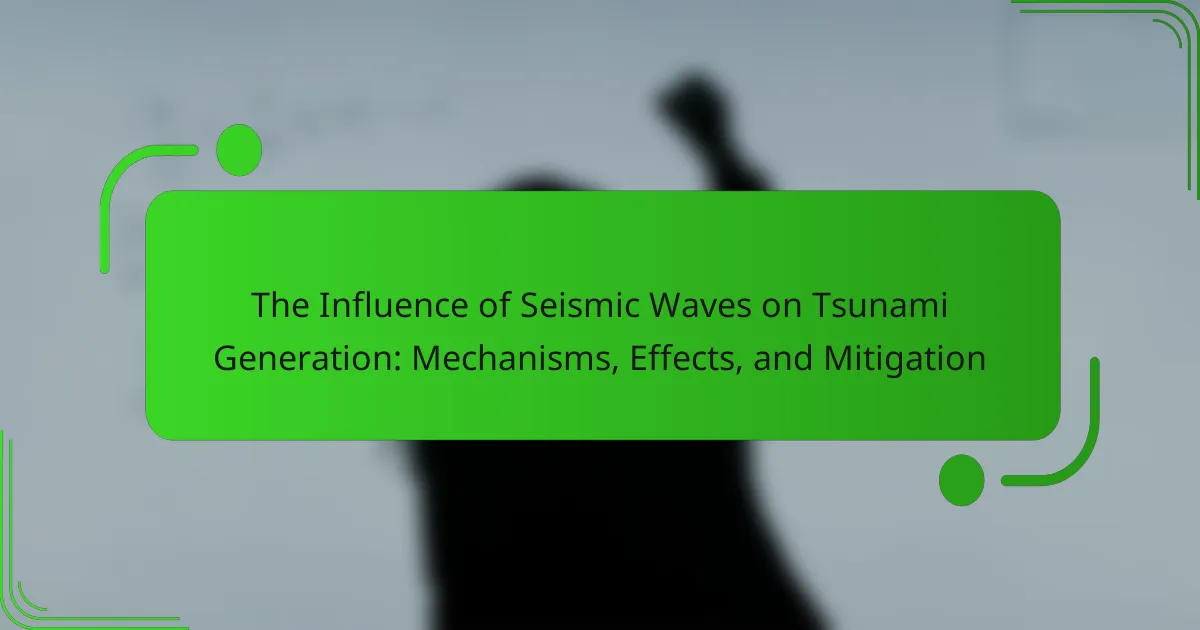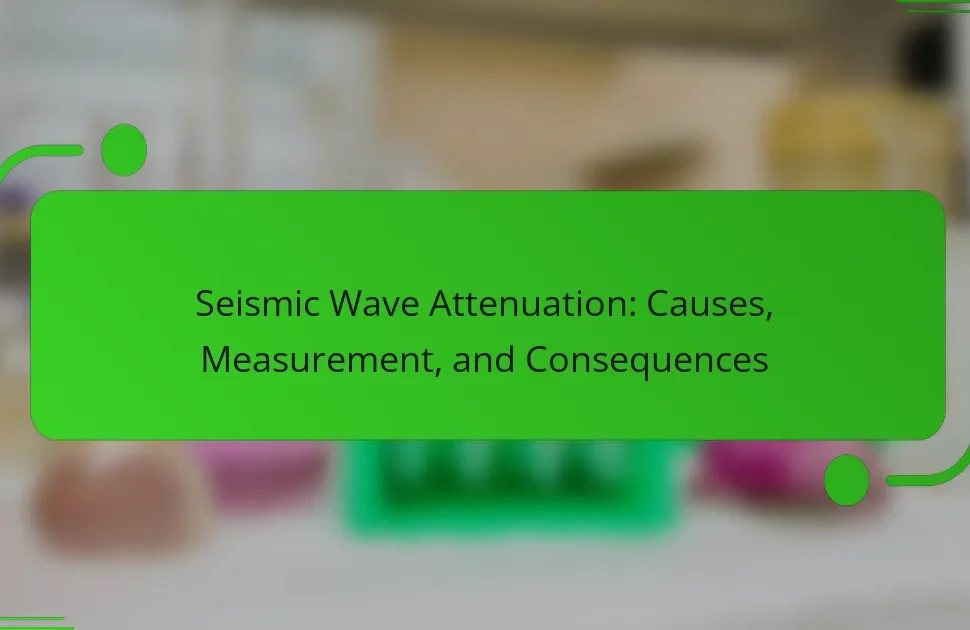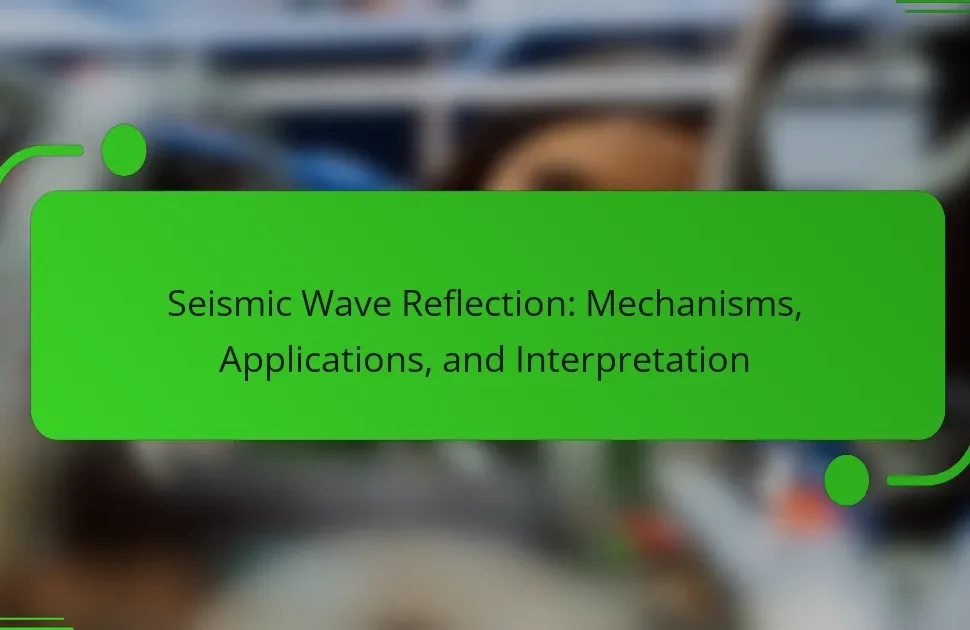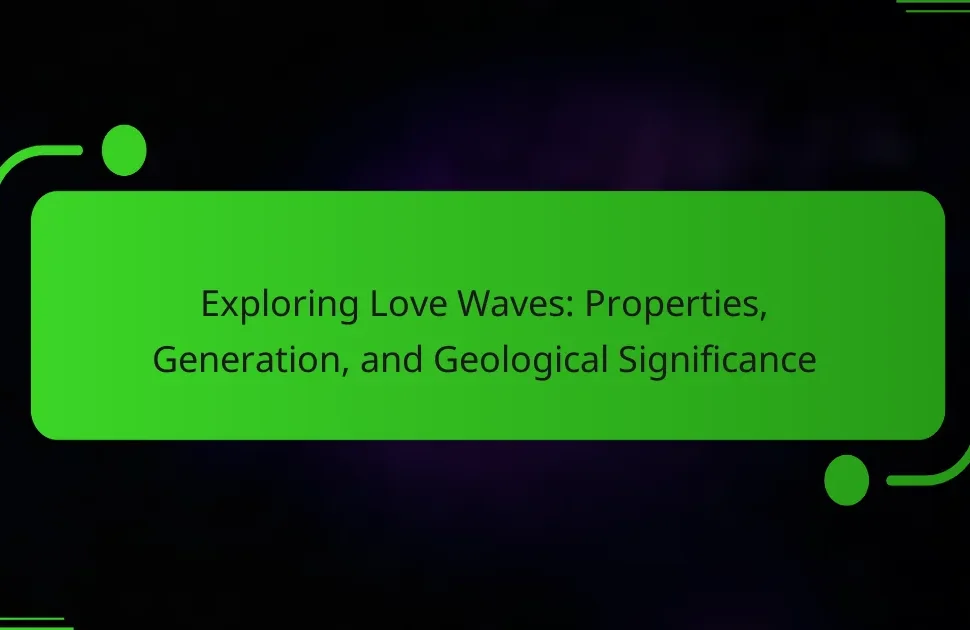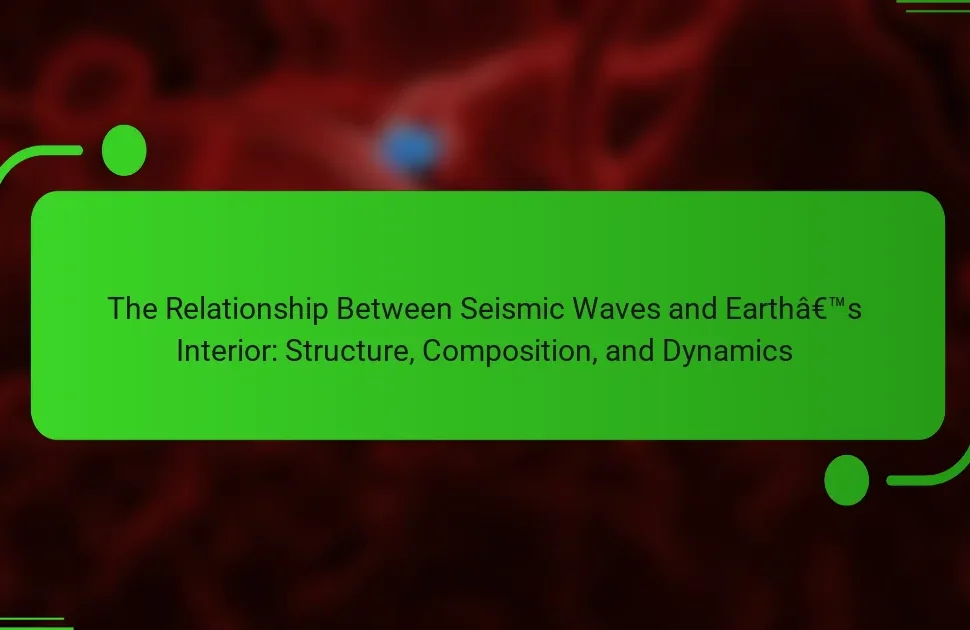Seismic waves are energy waves produced by the sudden movement of the Earth’s crust, primarily during earthquakes. These waves can displace large volumes of water, leading to the formation of tsunamis that travel across oceans and can cause significant destruction upon reaching coastal areas. The article examines the mechanisms by which seismic waves generate tsunamis, the devastating effects of these oceanic waves on human life and marine ecosystems, and effective mitigation strategies such as early warning systems and community preparedness. Historical examples, including the 2004 Indian Ocean tsunami and Japan’s response to the 2011 tsunami, highlight the importance of understanding and addressing the impacts of seismic activity on tsunami generation.
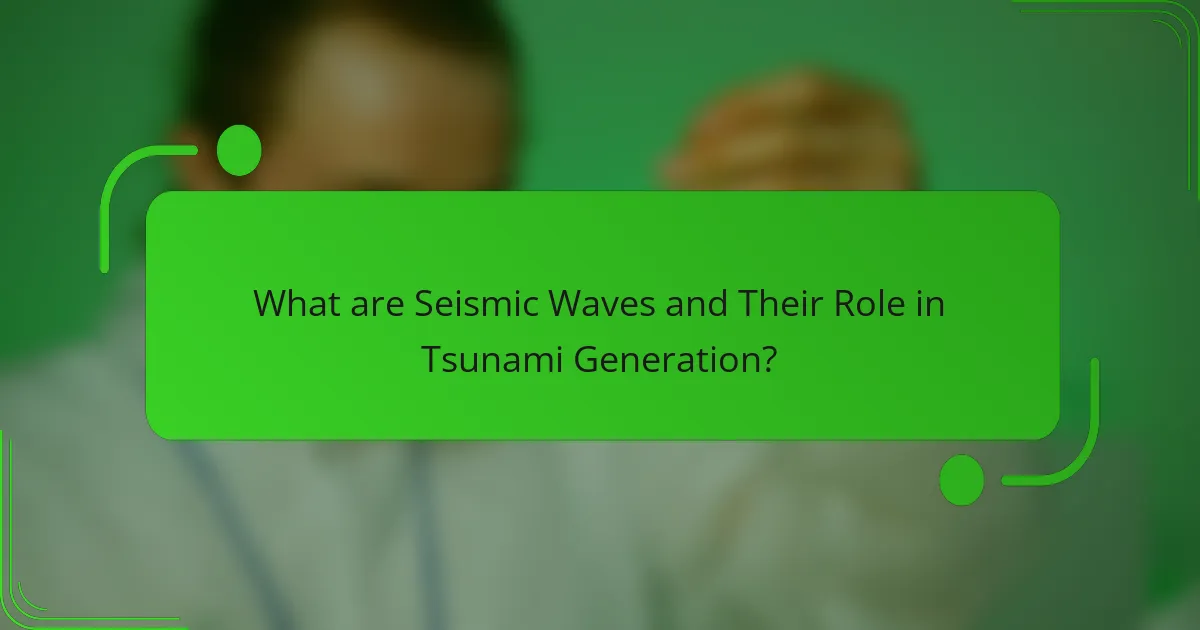
What are Seismic Waves and Their Role in Tsunami Generation?
Seismic waves are energy waves generated by the sudden movement of the Earth’s crust, typically during an earthquake. These waves travel through the Earth and can cause the seafloor to shift. When the seafloor moves abruptly, it displaces water above it, leading to the formation of a tsunami. Tsunamis can travel across oceans at high speeds, often reaching coastal areas with devastating effects. The 2004 Indian Ocean tsunami, triggered by a massive undersea earthquake, exemplifies this phenomenon, resulting in over 230,000 fatalities. Seismic waves play a crucial role in tsunami generation by initiating the underwater disturbances that lead to these large-scale oceanic waves.
How do seismic waves originate and propagate?
Seismic waves originate from the sudden release of energy in the Earth’s crust. This release usually occurs due to tectonic movements, such as faulting or volcanic activity. When the energy is released, it generates waves that travel through the Earth.
There are two main types of seismic waves: body waves and surface waves. Body waves include primary (P) waves and secondary (S) waves. P waves are compressional waves that travel fastest through solids and liquids. S waves are shear waves that only move through solids and arrive after P waves.
Surface waves travel along the Earth’s exterior and are generally slower than body waves. They cause most of the damage during an earthquake. Seismic waves propagate outward from the source in all directions. Their speed and intensity depend on the geological materials they traverse.
The propagation of seismic waves is influenced by the medium’s density and elasticity. Denser materials typically allow waves to travel faster. The study of seismic waves is crucial for understanding earthquakes and their potential to generate tsunamis.
What types of seismic waves are involved in tsunami generation?
Tsunami generation involves primarily two types of seismic waves: P-waves and S-waves. P-waves, or primary waves, are compressional waves that travel fastest through the Earth. They can move through both solid and liquid mediums. S-waves, or secondary waves, are shear waves that follow P-waves. S-waves only travel through solids and are slower than P-waves.
When an underwater earthquake occurs, the movement of tectonic plates generates these seismic waves. The energy released can displace large volumes of water, leading to a tsunami. The initial displacement of water is influenced by the characteristics of both P-waves and S-waves.
Research indicates that the magnitude and depth of the earthquake significantly affect tsunami generation. For instance, earthquakes with a magnitude above 7.0 are often capable of triggering tsunamis. Thus, the interplay of P-waves and S-waves is crucial in understanding the mechanisms behind tsunami formation.
How do the properties of seismic waves affect their impact on oceans?
Seismic waves affect oceans primarily through their energy release during underwater earthquakes. These waves can generate tsunamis, which are large ocean waves caused by sudden disturbances. The speed and frequency of seismic waves influence the intensity and reach of these tsunamis. For instance, shallow-focus earthquakes typically produce stronger waves that travel faster through water.
Research shows that seismic waves can displace large volumes of water, creating waves that can travel across entire ocean basins. The depth of the earthquake also plays a crucial role. Deeper earthquakes generally result in less destructive tsunamis due to the attenuation of wave energy.
Additionally, the type of seismic wave matters. P-waves, or primary waves, are faster and can be felt first, while S-waves, or secondary waves, are slower but can cause more significant ground shaking. This shaking can lead to underwater landslides, further contributing to tsunami generation.
In conclusion, the properties of seismic waves, such as speed, depth, and type, directly impact their ability to generate and influence oceanic waves and tsunamis.
What is the relationship between seismic activity and tsunamis?
Seismic activity is the primary trigger for tsunamis. When an earthquake occurs underwater, it can displace large volumes of water. This displacement generates waves that can travel across oceans. The magnitude and depth of the earthquake influence the size of the tsunami. For instance, earthquakes above magnitude 7.0 often lead to significant tsunamis. Historical events, such as the 2004 Indian Ocean earthquake, demonstrate this relationship. That earthquake had a magnitude of 9.1 and generated waves over 30 meters high. Thus, seismic activity directly correlates with the occurrence and intensity of tsunamis.
How do different magnitudes of seismic events influence tsunami formation?
Seismic events of varying magnitudes influence tsunami formation significantly. Larger magnitude earthquakes, typically above 7.0 on the Richter scale, are more likely to generate tsunamis. This is due to the substantial displacement of the ocean floor that occurs during such events. For instance, the 2004 Indian Ocean earthquake, which measured 9.1, caused a devastating tsunami affecting multiple countries.
Conversely, smaller earthquakes, usually below 6.0, rarely produce tsunamis. They may not generate enough energy to displace large volumes of water. The depth and location of the seismic event also play crucial roles. Shallow-focus earthquakes near oceanic trenches are more effective at generating tsunamis.
In summary, the magnitude, depth, and location of seismic events directly correlate with the potential for tsunami formation.
What are the geographical factors that affect tsunami generation from seismic waves?
Tsunami generation from seismic waves is influenced by several geographical factors. The depth of the ocean floor plays a crucial role. Shallow water can amplify wave energy, leading to larger tsunamis. The shape of the coastline also matters. Concave coastlines can funnel waves and increase their height. The angle of the seabed affects wave propagation. A steep slope can cause waves to rise quickly. Earthquake magnitude and location are significant as well. Subduction zones are particularly prone to generating tsunamis. Historical events, such as the 2004 Indian Ocean tsunami, illustrate these factors. In that case, a massive undersea earthquake triggered devastating waves due to the geographical features involved.
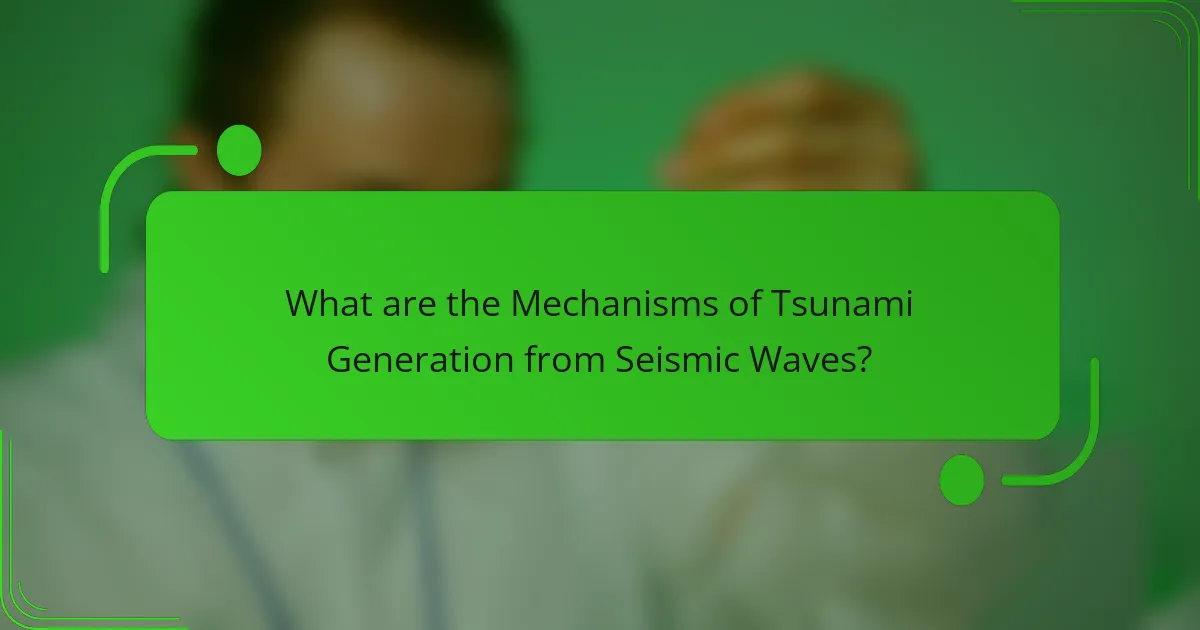
What are the Mechanisms of Tsunami Generation from Seismic Waves?
Tsunamis are generated by seismic waves primarily through underwater earthquakes. These seismic events displace large volumes of water, creating waves that travel across oceans. The displacement occurs when tectonic plates shift along faults, often at subduction zones. This sudden movement can lift or lower the seafloor, resulting in vertical water displacement. The energy from the seismic waves propagates outward, forming waves that can reach great heights as they approach shorelines. Historical data shows that significant earthquakes, such as the 2004 Indian Ocean earthquake, triggered devastating tsunamis, confirming this mechanism.
How do underwater earthquakes lead to tsunami formation?
Underwater earthquakes can lead to tsunami formation by displacing large volumes of water. When tectonic plates shift during an earthquake, the seafloor can suddenly uplift or drop. This movement generates waves that travel outward from the epicenter. The energy from these waves can propagate across the ocean at high speeds. As the waves approach shallow coastal areas, their speed decreases, but their height increases significantly. Historical data shows that tsunamis can reach heights of over 100 feet upon landfall. The 2004 Indian Ocean earthquake is a notable example, resulting in devastating tsunamis affecting multiple countries.
What is the process of seafloor displacement during an earthquake?
Seafloor displacement during an earthquake occurs when tectonic plates shift. This movement can happen along fault lines where plates interact. As stress builds up, it is released suddenly, causing the seafloor to lift or drop. The vertical movement of the seafloor displaces water above it. This displacement can generate tsunamis if the shift is significant. Studies show that major earthquakes, such as the 2004 Indian Ocean earthquake, resulted in substantial seafloor displacement. This event caused a tsunami that affected multiple countries, illustrating the connection between seafloor movement and tsunami generation.
How does the depth of the earthquake influence tsunami height?
The depth of an earthquake significantly influences tsunami height. Shallower earthquakes typically generate larger tsunamis. This occurs because the energy released at shallow depths is more efficiently transferred to the water column. For instance, earthquakes occurring at depths less than 30 kilometers often produce tsunamis that can reach considerable heights. Conversely, deeper earthquakes, those greater than 100 kilometers, generally result in smaller tsunami waves. Research indicates that the mechanism of wave generation is directly related to the fault movement and water displacement. Therefore, the relationship between earthquake depth and tsunami height is crucial for predicting tsunami impacts.
What role do volcanic eruptions play in tsunami generation?
Volcanic eruptions can generate tsunamis primarily through explosive activity and the collapse of volcanic islands. Explosive eruptions can displace large volumes of water, creating waves. The collapse of a volcanic island into the ocean can also trigger significant water displacement. Historical events illustrate this phenomenon, such as the 1883 Krakatoa eruption, which caused tsunamis that affected distant coastlines. These eruptions can lead to waves exceeding 30 meters in height. Additionally, underwater volcanic eruptions can create localized tsunamis. Such events are less common but can still pose significant risks. Overall, volcanic eruptions contribute to tsunami generation through various mechanisms of water displacement.
How can landslides contribute to tsunami events?
Landslides can contribute to tsunami events by displacing large volumes of water. When a landslide occurs near a body of water, it can rapidly push water aside. This displacement generates waves that can travel across the water surface. The size and speed of the generated waves depend on the landslide’s volume and speed. Historical events, such as the 1958 Lituya Bay landslide, demonstrate this phenomenon. In Lituya Bay, a massive landslide created a wave over 30 meters high. Such waves can lead to significant coastal flooding and damage. Thus, landslides are a critical factor in tsunami generation.
What are the differences in tsunami generation between earthquakes and volcanic activity?
Tsunamis generated by earthquakes differ from those caused by volcanic activity primarily in their mechanisms. Earthquakes typically generate tsunamis through the sudden displacement of the seafloor. This displacement occurs along tectonic plate boundaries, releasing immense energy. The 2004 Indian Ocean earthquake is a notable example, where a magnitude 9.1 quake triggered a devastating tsunami.
In contrast, volcanic activity can generate tsunamis through explosive eruptions or the collapse of volcanic islands. An example is the 1883 eruption of Krakatoa, which produced tsunamis due to the violent explosion and subsequent landslides.
The scale and impact of tsunamis from earthquakes tend to be larger due to the significant energy release. Conversely, tsunamis from volcanic activity may be localized but can still cause severe damage. The nature of the wave generation, therefore, is distinct, with earthquakes primarily causing tsunamis through tectonic movements and volcanism through explosive events or collapses.
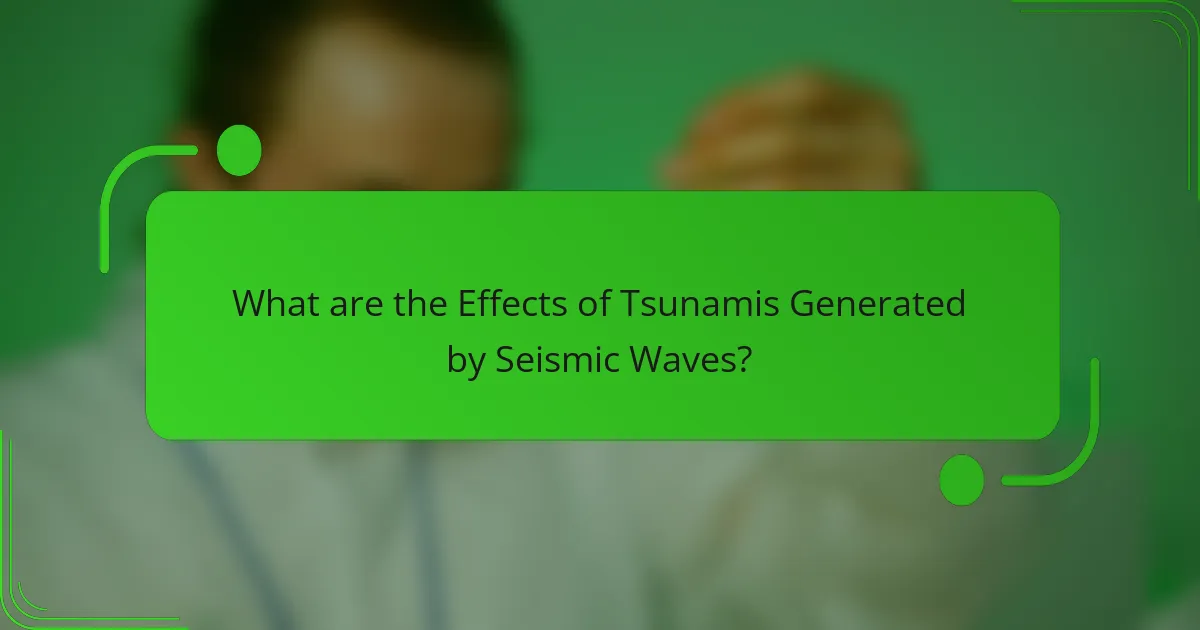
What are the Effects of Tsunamis Generated by Seismic Waves?
Tsunamis generated by seismic waves cause widespread destruction and loss of life. They can inundate coastal areas, leading to significant flooding. The force of the waves can destroy buildings and infrastructure. Tsunamis can also result in soil erosion and changes to coastal landscapes. The impact on marine ecosystems can be severe, disrupting habitats and killing marine life. Historical events, such as the 2004 Indian Ocean tsunami, illustrate these devastating effects, resulting in over 230,000 fatalities. Emergency response and preparedness are critical in mitigating these impacts.
What immediate impacts do tsunamis have on coastal regions?
Tsunamis have immediate and devastating impacts on coastal regions. They cause widespread flooding, submerging land and infrastructure. The force of tsunami waves can destroy buildings and sweep away vehicles. Coastal ecosystems suffer significant damage due to saltwater intrusion. The sudden influx of water can lead to loss of life and injuries among residents. Additionally, tsunamis can disrupt essential services like electricity and water supply. Historical events, such as the 2004 Indian Ocean tsunami, resulted in over 230,000 fatalities and massive economic losses. Tsunamis also generate strong currents that can pose risks to rescue operations and survivors.
How do tsunamis affect human populations and infrastructure?
Tsunamis significantly impact human populations and infrastructure. They can cause widespread destruction in coastal areas. The sudden surge of water can inundate homes, businesses, and critical facilities. For instance, the 2004 Indian Ocean tsunami resulted in over 230,000 fatalities and extensive damage across multiple countries. Infrastructure such as roads, bridges, and utilities often suffers catastrophic failure. Recovery from such events can take years, straining local economies. Tsunamis also lead to long-term displacement of communities. This can disrupt social structures and lead to mental health issues among affected populations.
What environmental changes occur due to tsunami events?
Tsunami events cause significant environmental changes. These changes include coastal erosion, habitat destruction, and salinization of freshwater sources. The force of tsunami waves can reshape shorelines and remove vegetation. Marine ecosystems may be disrupted due to sediment displacement. Flooding can lead to the contamination of land with debris and pollutants. Tsunamis can also alter the landscape by creating new channels and altering river paths. Historical data shows that the 2004 Indian Ocean tsunami caused extensive coral reef damage and mangrove loss. Such ecological impacts can take years or decades to recover fully.
What long-term consequences do tsunamis have on affected areas?
Tsunamis have significant long-term consequences on affected areas. They can lead to extensive coastal erosion, altering landscapes permanently. Infrastructure damage is often severe, requiring years for recovery. Economies may suffer due to the destruction of businesses and loss of tourism. Ecosystems can be disrupted, affecting local wildlife and plant life. Contamination of freshwater sources can occur, impacting public health. Displacement of communities often leads to long-term social challenges. Historical events, like the 2004 Indian Ocean tsunami, illustrate these enduring effects.
How do tsunamis influence local economies and ecosystems?
Tsunamis significantly impact local economies and ecosystems. They can cause extensive damage to infrastructure, leading to economic losses. For instance, the 2004 Indian Ocean tsunami resulted in an estimated $15 billion in damages. Local businesses often suffer due to destruction of property and loss of revenue. Recovery can take years, affecting employment and local investment.
Ecosystems also face disruption from tsunamis. Saltwater intrusion can harm freshwater sources and agriculture. Coastal habitats, such as mangroves and coral reefs, may be destroyed or altered. This affects biodiversity and the services these ecosystems provide.
In summary, tsunamis disrupt both economic stability and ecological balance, leading to long-term consequences for affected regions.
What are the psychological impacts on communities affected by tsunamis?
Tsunamis have significant psychological impacts on affected communities. Survivors often experience post-traumatic stress disorder (PTSD), anxiety, and depression. A study published in “Disaster Medicine and Public Health Preparedness” found that 30-40% of tsunami survivors reported PTSD symptoms. Communities face collective grief due to loss of loved ones and homes. This grief can lead to social withdrawal and a breakdown in community cohesion. Children are particularly vulnerable, often showing increased behavioral issues and academic difficulties. Long-term mental health services are essential for recovery. The psychological toll can hinder community rebuilding efforts and resilience.
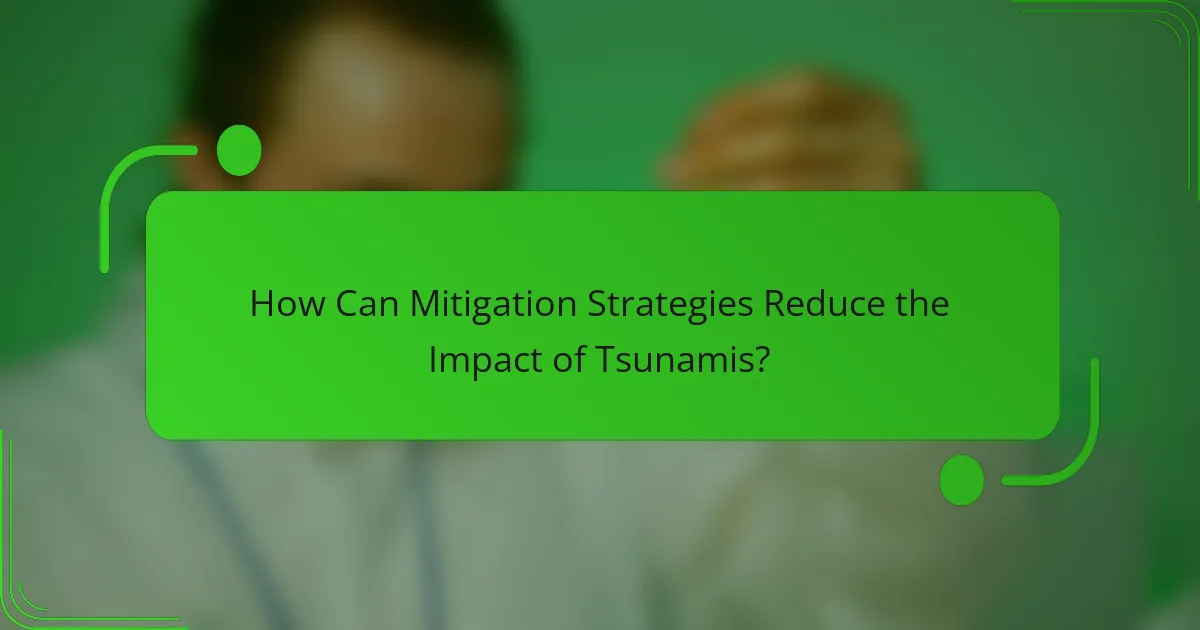
How Can Mitigation Strategies Reduce the Impact of Tsunamis?
Mitigation strategies can significantly reduce the impact of tsunamis through preparedness, early warning systems, and infrastructure improvements. Preparedness involves educating communities about tsunami risks and evacuation routes. Early warning systems can detect seismic activity and provide alerts minutes before a tsunami strikes. This can save lives by allowing people to evacuate to higher ground. Infrastructure improvements include building seawalls and designing buildings to withstand tsunami forces. Historical data shows that regions with robust mitigation strategies experience fewer casualties and damages during tsunamis. For example, Japan’s extensive tsunami preparedness measures reduced fatalities during the 2011 tsunami.
What are the best practices for tsunami preparedness and response?
The best practices for tsunami preparedness and response include developing a tsunami evacuation plan. Communities should identify safe evacuation routes and establish designated meeting points. Regular tsunami drills enhance public awareness and readiness. Emergency kits with essential supplies should be prepared in advance. Public education campaigns can inform residents about tsunami risks and warning signs. Local authorities should establish a reliable tsunami warning system to provide timely alerts. Collaboration with scientific organizations can improve monitoring and forecasting capabilities. Historical data from past tsunamis can guide future preparedness efforts.
How can early warning systems improve tsunami response times?
Early warning systems can significantly improve tsunami response times by providing timely alerts to coastal communities. These systems utilize seismic data to detect underwater earthquakes that may trigger tsunamis. Once an earthquake is identified, the system calculates the potential for tsunami generation and disseminates alerts within minutes.
For example, the Pacific Tsunami Warning Center can issue warnings based on seismic activity detected by its network. Studies indicate that timely alerts can reduce casualties by allowing people to evacuate to higher ground before the tsunami arrives. The effectiveness of these systems is evidenced by historical data showing improved response times and reduced fatalities in areas with established warning systems.
What role do community education and drills play in tsunami mitigation?
Community education and drills are crucial for tsunami mitigation. They enhance public awareness about tsunami risks and safety protocols. Educated communities can respond more effectively during an actual tsunami event. Drills simulate real-life scenarios, allowing individuals to practice evacuation routes and safety measures. Research indicates that communities with regular drills have higher survival rates during tsunamis. For example, the 2011 Tōhoku earthquake in Japan highlighted the importance of preparedness. Informed citizens can make quicker decisions, reducing panic and chaos. Overall, community education and drills significantly improve resilience against tsunamis.
What engineering solutions are available to protect coastal areas from tsunamis?
Engineering solutions to protect coastal areas from tsunamis include tsunami walls, breakwaters, and early warning systems. Tsunami walls are constructed to absorb and deflect wave energy. Breakwaters reduce wave height and energy before reaching the shore. Early warning systems use seismic data to alert communities of impending tsunamis. These systems can provide crucial minutes for evacuation. Research indicates that well-designed tsunami walls can significantly reduce the impact of waves on coastal infrastructure. Studies show that breakwaters can lower wave energy by up to 50%. Early warning systems have proven effective in saving lives during past tsunami events.
How effective are seawalls and other barriers in mitigating tsunami damage?
Seawalls and other barriers can be effective in mitigating tsunami damage, but their effectiveness varies. Research indicates that while they can reduce wave energy, they do not completely prevent inundation. For example, the 2011 Japan tsunami demonstrated that seawalls failed to protect certain areas despite their height. Studies show that properly designed barriers can reduce wave height by up to 50%. However, the design must consider local conditions and tsunami characteristics. Additionally, barriers may redirect water, causing increased flooding in adjacent areas. Overall, while beneficial, reliance solely on seawalls is insufficient for comprehensive tsunami risk management.
What are the limitations of current mitigation technologies?
Current mitigation technologies for tsunami generation have several limitations. These technologies often rely on early warning systems that can be inaccurate. False alarms can lead to public desensitization and reduced trust in warnings. Additionally, mitigation measures such as sea walls may not withstand extreme tsunami forces. They also require significant financial investment and maintenance. Current models for predicting tsunami behavior can be limited in accuracy. They may not account for local geological variations. Furthermore, many communities lack the infrastructure for effective evacuation routes. These factors collectively hinder the effectiveness of tsunami mitigation strategies.
What can individuals do to prepare for potential tsunami threats?
Individuals can prepare for potential tsunami threats by creating a family emergency plan. This plan should include designated meeting points and communication methods. Individuals should also identify evacuation routes in their area. Knowing the quickest way to higher ground is essential. It is advisable to assemble an emergency kit. This kit should contain food, water, and medical supplies for at least 72 hours. Staying informed about tsunami alerts is crucial. Individuals can sign up for local alert systems to receive timely warnings. Familiarizing oneself with tsunami risk zones can enhance preparedness. According to the National Oceanic and Atmospheric Administration (NOAA), education and planning significantly reduce tsunami-related risks.
What resources are available for personal tsunami preparedness planning?
Resources for personal tsunami preparedness planning include government websites, community programs, and educational materials. The National Oceanic and Atmospheric Administration (NOAA) provides guidelines on tsunami safety. The Federal Emergency Management Agency (FEMA) offers a tsunami preparedness toolkit. Local emergency management offices often conduct workshops and drills. Online resources like Ready.gov provide checklists and planning guides. Tsunami warning centers share real-time alerts and evacuation routes. Educational institutions may offer courses on disaster preparedness. These resources help individuals create effective emergency plans.
How can communities collaborate to enhance tsunami resilience?
Communities can collaborate to enhance tsunami resilience by developing comprehensive emergency response plans. These plans should include evacuation routes, communication strategies, and resource allocation. Regular community drills can improve preparedness and ensure all members understand their roles. Local governments can partner with organizations like the National Oceanic and Atmospheric Administration (NOAA) for training and resources. Engaging in public education campaigns raises awareness about tsunami risks and safety measures. Establishing early warning systems allows timely alerts to residents. Collaborating with scientists can improve understanding of local tsunami risks and inform mitigation strategies. Research shows that communities with strong collaboration have better outcomes during disasters.
The main entity of this article is seismic waves and their role in tsunami generation. The article provides a detailed examination of how seismic waves, originating from underwater earthquakes, displace water and lead to the formation of tsunamis. It discusses the mechanisms of tsunami generation, the impact of different magnitudes of seismic events, and the geographical factors that influence tsunami formation. Additionally, the article explores the immediate and long-term effects of tsunamis on human populations and ecosystems, as well as mitigation strategies that can reduce their impact, including early warning systems and community preparedness initiatives.
